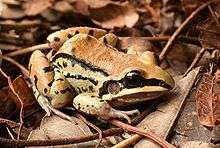Leptodactylus mystacinus
Leptodactylus mystacinus is a species of frog in the family Leptodactylidae. It is found in eastern Bolivia and eastwards to Brazil, Paraguay, and Uruguay and southwards to central Argentina.[1][2][3] It is also known as the mustached frog.[2][3]
| Leptodactylus mystacinus | |
|---|---|
 | |
| Scientific classification | |
| Kingdom: | Animalia |
| Phylum: | Chordata |
| Class: | Amphibia |
| Order: | Anura |
| Family: | Leptodactylidae |
| Genus: | Leptodactylus |
| Species: | L. mystacinus |
| Binomial name | |
| Leptodactylus mystacinus (Burmeister, 1861) | |
| Synonyms[2] | |
| |
Description
Adult males measure 44–65 mm (1.7–2.6 in) and adult females 54–67 mm (2.1–2.6 in) in snout–vent length. The snout in males is more spatulate than in females. A pair of dorsolateral folds runs from behind the eye to the upper groin; a second pair is either incomplete or interrupt and starts from the forearm insertion and runs along the flanks. The toes lack fringes and fleshy ridges, the toe tips are narrow. The dorsum is uniform, striped, or bears small dark spots. The upper pair of dorsolateral folds is lined with a distinct dark brown stripe or band below and usually with a light pinstripe above; the latter becomes often broader and more distinct posteriorly. The lower dorsolateral folds along the flanks may have dark or cream highlights, or both. The upper lip typically has a distinct light stripe. The venter ranges from being immaculate to mottled.[3]
Habitat and conservation
Leptodactylus mystacinus is a terrestrial frog found in grasslands near standing bodies of water, its breeding habitat. Reproduction takes place in under-ground foam nests; the tadopoles develop in water. Some populations are found in forests and formerly forested areas. It is found at elevations below 1,800 m (5,900 ft). It is a common species that adapts well to human disturbance. It occurs in several protected areas and is not considered threatened by the International Union for Conservation of Nature (IUCN).[1]
References
- Heyer, R.; Silvano, D.; Reichle, S.; Lavilla, E. & di Tada, I. (2010). "Leptodactylus mystacinus". IUCN Red List of Threatened Species. 2010: e.T57147A11591930. doi:10.2305/IUCN.UK.2010-2.RLTS.T57147A11591930.en.
- Frost, Darrel R. (2019). "Leptodactylus mystacinus (Burmeister, 1861)". Amphibian Species of the World: an Online Reference. Version 6.0. American Museum of Natural History. Retrieved 4 February 2019.
- Heyer, Miriiam Muedeking; Heyer, W. Ronald; Spear, Stephen & de Sá, Rafael O. (2003). "Leptodactylus mystacinus". Catalogue of American Amphibians and Reptiles. 767: 1–9. doi:10.15781/T2RR1PR7C.
| Wikimedia Commons has media related to Leptodactylus mystacinus. |
